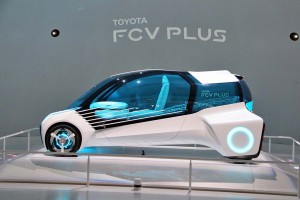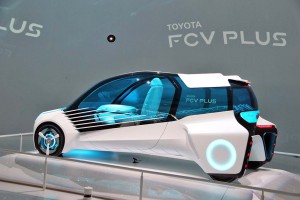The funky styling of the new Toyota Mirai hydrogen car has already been raising some eyebrows, but if you think that’s pushing the envelope, well, as the old saying goes, you ain’t seen nothing’ yet.
The fundamentals of a fuel-cell vehicle are radically different from those of a car using an internal combustion engine, and Toyota takes things to a radical extreme with the FCV Plus concept vehicle that made its debut at the Tokyo Motor Show this week.
With the basic hardware driving the prototype neatly tucked away, the FCV devotes virtually every inch above the floorboards to passengers and cargo, resulting in a design that might seem more at home on the set of a science fiction flick than on today’s highways.
Advocates argue that hydrogen is the cleanest and most efficient alternative to gasoline. Toyota has become one of the leading proponents of the lightweight, super-clean fuel, predicting “a sustainable society in which hydrogen energy is in widespread use.”
The Toyota Mirai, just going on sale in Japan, with the U.S. to follow, is one of three hydrogen cars that will be available on the retail market by next year. Hyundai launched a fuel-cell version of its Tucson SUV last year, and Honda is set to follow with a new model called the Clarity. Despite a few edges touches, all three follow relatively conventional automotive design conventions.
(Honda clarifies its fuel-cell plans with debut of 2016 Clarity. Click Here to check it out.)
Not so the Toyota FCV Plus concept vehicle. While it does have doors, a roof and four wheels, that’s where all resemblances end. The fuel-cell stack is tucked way up front and takes up virtually none of the space above the floor. The hydrogen tanks are similarly sequestered in the rear. Meanwhile, the FCV Plus is driven by four in-wheel motors.
That layout has a variety of advantages. It means a potentially efficient form of all-wheel-drive and allows for smooth torque vectoring. Meanwhile, it frees up a lot of space in the interior, making even a 4-seat car with a compact footprint feel positively cavernous inside.
(Click Here for the dozen biggest debuts at the Tokyo Motor Show.)
The body structure appears to be some sort of lightweight material, likely carbon fiber. And that should help a vehicle like the Toyota FCV Plus improve both range and performance. The Mirai already can deliver about 300 miles between hydrogen fill-ups.
Where to fill up is a big issue right now, with only a few dozen hydrogen stations in the entire U.S., and most of those in Southern California. The Golden State is planning to boost its own tally to 100 or more within the decade, and other states are looking to get into the game, as well. Toyota’s home market Japan is, meanwhile, looking to set up a hydrogen refueling network in time for the 2020 Olympics.
Fuel cell stacks combine compressed hydrogen and oxygen from the air to create electric current. The only byproduct is water vapor.
Toyota notes that a vehicle like the FCV Plus could serve double-duty as a mobile generator. A family living off the electric grid could use the car instead of a generator, for example. Or it could provide power for anything from a tailgate party to a work site.
“Fuel cell vehicles will take on a new role as power sources within their communities,” says a Toyota statement.
The Toyota FCV Plus is, for now, nothing but a show car. But it’s one meant to show the extreme possibilities that could follow a switch to a radically new energy source.
(To see more about why green car buyers pay with “green,” Click Here.)


